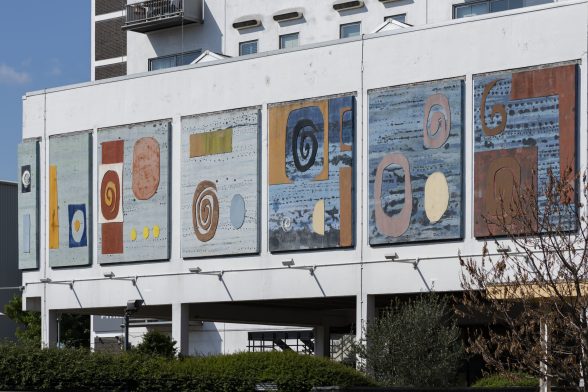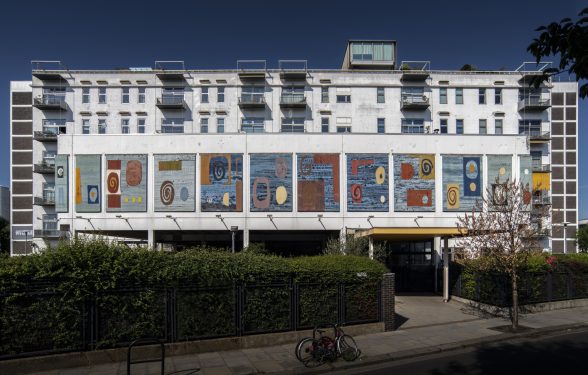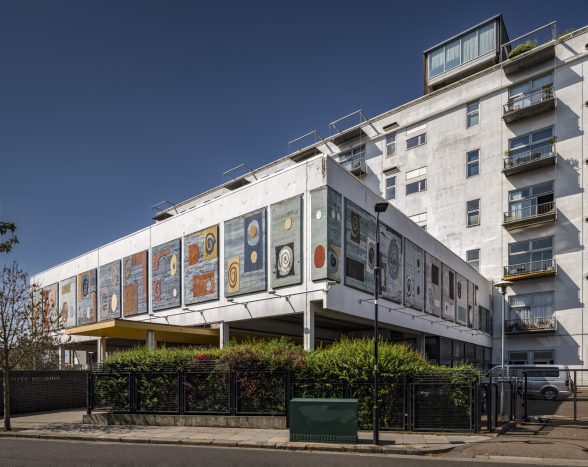This website uses cookies
This website uses cookies to enable it to function properly and to analyse how the website is used. Please click 'Close' to accept and continue using the website.



Image: Historic England
A mural by celebrated artist John Piper in Fulham, London featuring twenty-nine abstract decorative panels has been Grade II listed, along with the former exhibition building they are attached to. It represents another success for C20’s long running campaign to recognise and preserve the nations immense legacy of post-war murals and public art.
The colourful fibreglass artwork, known as the ‘Spirit of Energy’, was commissioned to cover three sides of the exhibition block of the North Thames Gas Board headquarters on Peterborough Road. They occupy a total area of approximately 250m² making them one of John Piper’s largest single commissions – thought to be second only to his Baptistry window at Coventry Cathedral. Perhaps best known for his paintings, Piper also worked with skilled craftspeople to fulfil many public and applied arts commissions. The main headquarters building, now known as the Piper building, was built for the Gas Board in the late 1950s but converted to residential and other uses in the 1990s – it is not included in the listing.

Image: Historic England
Piper collaborated with Gillespie and Manzaroli Associates to produce the panels between 1961-62, they have the hand-made appearance of paper cut-outs but made to an architectural scale in industrial materials. This commission was also believed to be Piper’s first time working with fibreglass.
The panels are attached to the former exhibition block; a two-storey white-rendered building, which originally housed conference rooms and an exhibition space raised on slim columns (piloti) above an entrance hall and showroom beneath, which now serves as the main entrance to the Piper residential building. They’re the only known example of a permanent outdoor artwork in John Piper’s large and diverse body of work, and the building is integral to the way in which the artwork is encountered and perceived.
The Piper mural fit into a wider trend of outdoor art at the time. The years following the Second World War saw a rise in the creation of public art, designed to bring public spaces back to life as the country began to repair its shattered towns and cities.

Image: Historic England
This idea was brought to a wide audience through the Festival of Britain in 1951. Visitors to the Festival saw around 30 sculptures and more than 100 murals integrated into the buildings and spaces of the South Bank site, commissioned from artists including John Piper. New or alternative materials such as concrete, mosaic and fibreglass were popular as they lent themselves to texture and relief and could withstand the elements.
Catherine Croft, Director, the Twentieth Century Society, said:
“C20 Society has long been campaigning for the national importance of post-war murals to be recognised and we’re delighted to see the John Piper murals in Fulham listed. Murals are for everyone and the mid-20th century was a time of tremendous experimentation and exuberance for art in the public realm.
This is a rare and innovative installation, expressing many of the motifs that the artist favoured in his larger works, while skilfully using colour to create a contrasting sequence of images as they progress around the building. They make an effervescent and uplifting contribution to the streetscape.”
Tom Foxall, Head of Region, London and the South East, Historic England, added:
“From painter and official war artist to printmaker and stained glass designer, John Piper was a major figure in 20th century British art with an extraordinary breadth of work. These panels exemplify Piper’s continual experimentation with new materials and are a joyful, much-loved local landmark that meets the high bar for listing.”

Become a C20 member today and help save our modern design heritage.